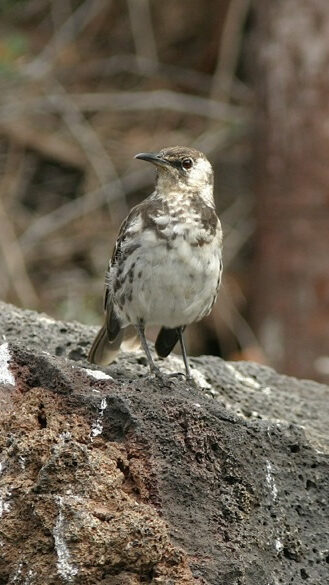Stuart Pimm asks if he should be surprised to see a bird so close to extinction. From results in a paper just published in “Conservation Biology,” he concludes that such an event should be a once in a millennium experience. That it isn’t, tells us that human actions are causing species to go extinct thousands of times faster than expected.
I was excited to see the mockingbird on the black lava. It wasn’t just any mockingbird. It was one of Darwin’s mockingbirds. That different islands in the Galapagos, so close together, had different species, Darwin found “scarcely credible.” Species were being born here, he realised. He questioned how.
I almost didn’t see the mockingbird. Only about 150 birds remain on two small islets. Introduced rats, cats, dogs, and goats exterminated the much larger population that Darwin saw on nearby Floreana Island. Encounters with other species — like the ‘alala, the Hawaiian crow, where I saw every living bird one day — and I had a question. Should I be surprised to see a species dying out?


Treat the question as if species were humans: read the obituaries. The Red List of the International Union for the Conservation of Nature, lists species that have gone extinct — as the ‘alala now is in the wild — or are perilously close to doing so, as with the Floreana mockingbird.
We express these numbers in similar terms to human deaths. In the rich language of the King James’ Bible, we humans last “three score years and ten.” Converted to a rate, this equates to somewhere between one and two deaths for one hundred people, per year.
Work that my colleagues and I published in Science earlier this year, shows that amphibians, birds, and mammals are currently dying off at the rate of a few hundred extinctions per one million species per year. Different numbers, same idea.
What rate of species’ deaths should we expect? How much worse are things now than before humans massively changed the planet? These are surprisingly difficult questions to answer, but colleagues and I have made a stab at it in a paper just published online in the journal Conservation Biology.
Fossils help. Look at a slab of rock — the Grand Canyon will do — and see how many feet of rock span from when a species first appears to when it disappears. Geologists can age the rocks and estimate a fossil’s equivalent of our human three score and ten. It’s not a very good estimate. We don’t know whether a fossil lived somewhere else beforehand or afterwards.
What the fossils do tell us is that, apart from a few cataclysms such as the one that took out the dinosaurs, biodiversity has increased. The population of species is growing. That means that lineages of species are becoming more diverse. They have higher “birth” rates — speciation rates — than “death” rates — extinction rates.
We know how fast species are diversifying thanks to thousands of studies of molecular phylogenies. For example, these show that our nearest human relatives are bonobos, which are closely related to chimpanzees, we are less close to gorillas, still less to other apes, and so on. Drawing out these trees of who is related to whom was Darwin’s idea. These days, we can do so with great precision and estimate the times when groups of species split from each other.
I’d better tell you who the “we” is. I haven’t worn a lab coat since I was 19 and remember extracting DNA from cells with the horror some people have for calculus. I needed help. I found Juri de Vos, when I listened to a seminar he gave in Switzerland a couple of years back. He’s the lead author on the paper, a team of us have just published.
“We cannae go any faster, captain” Scotty tells Kirk on the Starship Enterprise. So, how fast can nature produce new species? Juri’s seminar provided the answer.
Just like a human birth rate — of one of two babies per hundred people per year — we express the rate similarly: Juri was telling me that the rate for most species was about one new species, per ten million species per year. Different numbers, same idea.
As with most science, there are complications. Might species be living fast and dying young? The natural extinction rate might be high, but the speciation rate just slightly larger. Well, the fossils tell us this isn’t happening. So, too, do the phylogenies.
Thankfully, I’m richer than I was when I was 19. That tells you I’ve earned more (“birth rate”) than I’ve spent (“death rate”), but not how much I earn or spend. If I looked very closely at my daily net worth, I’d see a blip each month when I get paid. The same should apply to species. If the extinction rate were very high, we’d see lots of very new species compared to what there were in the past. These haven’t gone extinct yet — there hasn’t been time — much as I my bank balance looks great on payday because I haven’t paid the bills yet. Juri and I didn’t see such blips in the data: species aren’t living fast and dying young.
So, nature diversifies creating one new species for every ten million species each year. We, however, are destroying hundreds of species per million species — and so thousands of species per ten million species, each year. Juri, my colleagues and I concluded that human actions are destroying species thousands of times faster than nature is creating them. That’s a truly awful statistic. It means that if current trends continue our descendants will inherit a much-depleted planet.
I can put this another way. Since there are 10,000 species of birds, seeing one go extinct should be a once in a millennium event. I should have been very surprised and worried by the mockingbird. And I was.
—Stuart Pimm
Board of Advisors, E.O. Wilson Biodiversity Foundation

